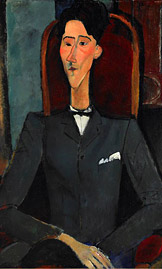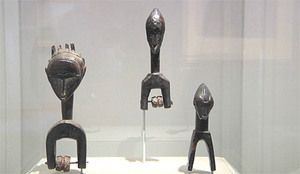Here’s another new(ish) trend in museums: not satisfied with mixing fine art and decorative art, some are reinstalling galleries to integrate art made in different geographic areas and cultures, too.
 The Princeton University Art Museum is a prime example. James Steward, the director, said two years ago, when he was appointed, that he wanted to rearrange the collection to make it more accessible to more people. Now the reinstallation is complete. I hasten to add that I have not seen it, but I’ve gleaned this information from the Princeton article, in which Steward says:
The Princeton University Art Museum is a prime example. James Steward, the director, said two years ago, when he was appointed, that he wanted to rearrange the collection to make it more accessible to more people. Now the reinstallation is complete. I hasten to add that I have not seen it, but I’ve gleaned this information from the Princeton article, in which Steward says:
For pragmatic reasons, we thought it would be interesting to create some new juxtapositions across collections, across cultures….Intellectually, it felt to us that this would bring our practice as a museum much more in line with what has been happening in the broader academy for the last 20 or more years: crossing disciplinary borders more regularly, looking to find the connection between and through disciplines, and to speak to points of cultural contact.
Thirteen galleries for European and American art were involved. Not surprisingly, one example of the juxtapositions has a Modigliani painting (right) placed near pulleys from 19th century West African looms (below). “…this is exactly the sort of African art that he was looking at and was interested in. And when you look at the treatment of the face — the way that the eyebrow is related to the nose, the elongation of the face and the chin, and the somewhat diamond-shaped mouth — all of those stylizations of the features really resonate with the African objects,” said Caroline Harris, curator for educational and academic programs at the museum, in the article.
 The other example is also a little predictable:
The other example is also a little predictable:
…the 1888 painting, “Tarascon Diligence, “(Tarascon Stage Coach) by Dutch artist Vincent van Gogh is displayed near two 1856-57 Japanese woodblock prints from the series “100 Views of Edo” by Ando Hiroshige. A nearby label explains that many avant-garde artists of the late 19th century abandoned traditional European painting practices and looked to non-Western art forms, such as Japanese prints, for innovative approaches to composition and color.
Steward’s goal is admirable, but the examples make one wonder if this idea can be sustained. It could old very quickly. But he will soon have more help to work on it. The article — PR, really, considering the source, also said that:
The museum recently received a $500,000 grant from the Andrew W. Mellon Foundation of New York to support an expansion of this effort, called “Activating the Collections.” The award will fund, in part, the establishment of a new position, a curatorial fellow for collections engagement, who will work with curators, faculty, students, guest scholars, artists and other experts across disciplines to develop and present compelling interpretative approaches and materials.
Know any creative minds?
UPDATE: PAM posted a YouTube explanation of its display philosophy here.
(BTW, I’ve covered other recent installation innovations, like the “taste of” gallery, here.)
Photo Credits: Courtesy of Princeton University
